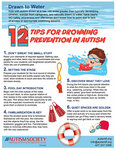In the state of Florida, there is nearly always a danger of children drowning, but as summer approaches, that danger becomes even more clear.
Join our family of readers for as little as $5 per month and support local, unbiased journalism.
Already have an account? Log in to continue. Otherwise, follow the link below to join.
Please log in to continue |
.jpg)

OKEECHOBEE — In the state of Florida, there is nearly always a danger of children drowning, but as summer approaches, that danger becomes even more clear.
Stacey Hoaglund, president of the Autism Society of Florida, said families who care for a loved one with autism have more reason to fear drowning than those who are not on the spectrum. “Children and adults with autism tend to wander or elope,” she said. “And they are almost always attracted to water.”
The chances of a drowning accident are 160 times greater for children or adults with autism, she said. “The kids are self-directed and don’t really stop and think…oh, Mom and Dad might be looking for me, so I should probably go check in.”
Hoaglund is an educational advocate and said one of the students she recently worked with loved to go stand by the door of his classroom in hopes he could get out when it opened. “He is what we call an eloper, not just a wanderer, He wants to get out of that room.”
“There is research that tells us 48% of children with autism wander, but I have never met a parent of any kid with autism whose kid did not wander, at least from time to time.”
Hoaglund said maybe the 48% were more elopers (like the little boy in the classroom) than wanderers.
She explained that in the state of Florida, the Department of Children and Families keeps track of deaths and their causes, including drowning. Since January 1, 2023, there have been 30 drownings in Florida, she said. “All but two of these were wanderers who just wandered out of the house. 25 % of them had autism diagnoses.”
She went on to say that not all of those children had been identified as having autism, but because autism is not typically diagnosed until the age of 4 1/2, we have no way of knowing if those children would later have been diagnosed.
“So, that 160 times greater that research shows may or may not be accurate,” she said. “With children drowning at such a young age, we just don’t know what we don’t know.”
The Autism Society of Florida wants to make parents aware of the dangers that could be out there for their children and to make them more diligent in keeping their children safe.
The following suggestions were compiled by the society to help with this:
Swim lessons are a must. Contact local pools,
YMCAs, and CARD (Centers for Autism and Related Disabilities) for information on where to find swimming lessons in your area.
Start with sensory integration. Ease your child into a water experience, don’t rush it. Allow them to put their feet in from the side of the pool, hang out on the steps, gradually move into deeper waters while you spend countless hours in the pool yourself so that you can be part of the process to their comfort and success.
Seek out a pool that matches your child’s learning style. If your child is easily distracted by others, sign them up for a class during an off-time when there won’t be many other swimmers in the pool. When there are others in the pool, turn their body away from the others to reduce visual stimulation. None of us learn best when we’re distracted.
Engage before swimming lessons begin. Take your child for a tour of the pool where they’ll be taking lessons. This will give them a chance to get used to the sights, smells, and sounds that they’ll be experiencing as part of this process.
Create visuals of the steps to be expected in the pool, and instructions on swimming. Be sure to laminate these so that they can be brought into the water. Video modeling is a fabulous way to present an introduction to swimming. If you can’t find one, create one with your smartphone, using a sibling or friend as your “actor”.
Be consistent in the instruction. Review previously taught skills at every lesson to ensure maintenance.
Create water rules. Kids and adults with autism tend to like rules since they give them clearly defined boundaries and expectations.
These can include:
Take steps to prevent wandering. Place alarms or chimes on doors, always be sure to lock access points around pools, and place “Stop” signs on all doors and windows leading to the outside.
Consider a locating device. Check with your local police department to find out which ones are active in your area.
Alert Your Neighbors. Spend time introducing your child to those who live in your neighborhood. Knowing your neighbors can help reduce the risks associated with wandering and reduce the need for emergency professionals.
Visit Local Authorities. Set up a visit to the police department during a NON-EMERGENCY time so that your child will get to meet those who serve and protect AND give the officers the opportunity to learn about autism and ways that they can help prevent tragedy
For more information on the Autism Society of Florida, call 407-207-3388 or email info@autismfl.org.